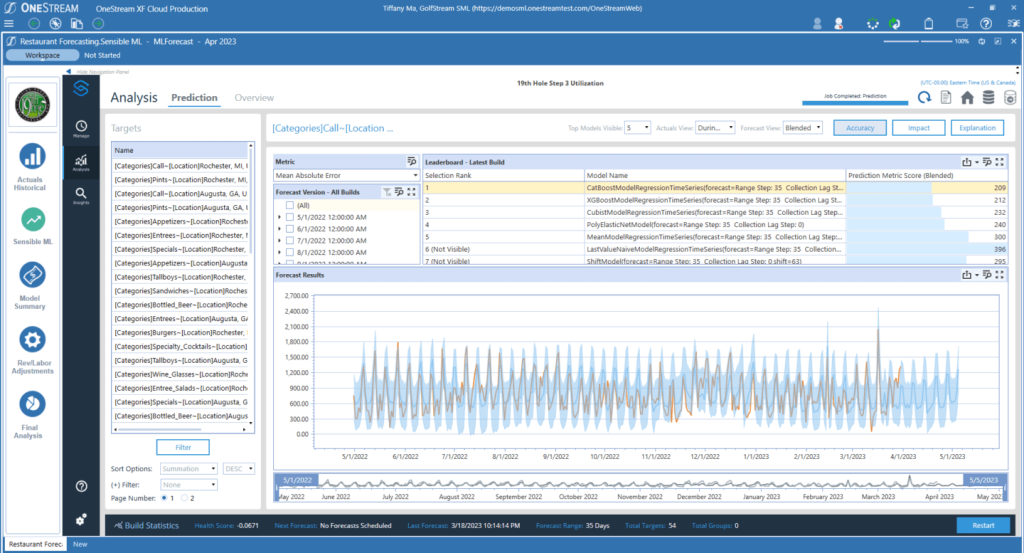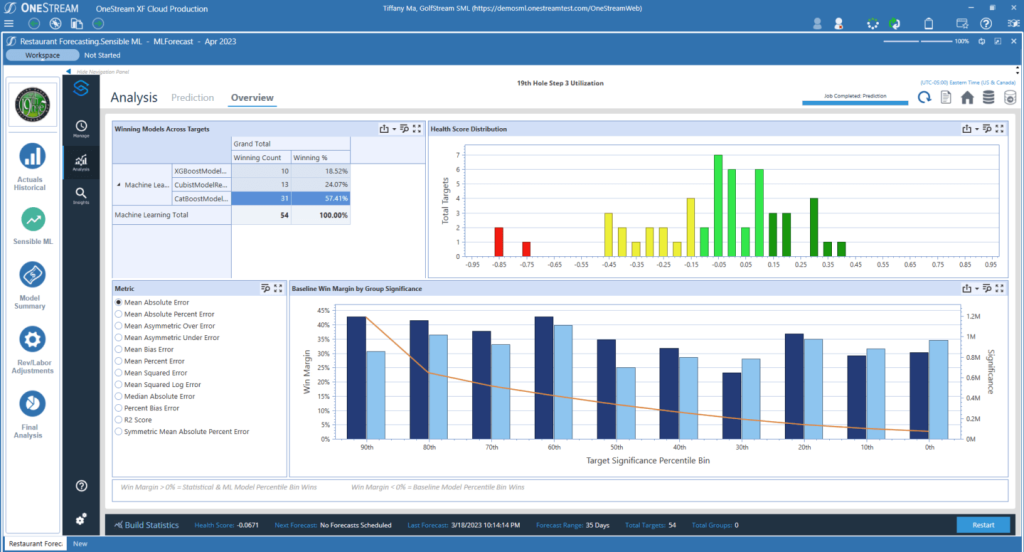This article first appeared on the OneStream blog by Joel Bittick
That’s where artificial intelligence (AI) and machine learning (ML) forecasting come in – these technologies can help businesses power their scenario plans with more accurate and reliable data, allowing them to make better-informed decisions and stay ahead of the curve.
Powering Scenario Plans with AI & ML Forecasts
Scenario planning involves creating multiple possible futures for a business, considering a range of different variables such as market trends, consumer behavior, and technological advancements. The process typically involves identifying key drivers of change, developing a range of plausible future scenarios, and assessing the potential impact of each scenario on the organization.
The goal is to identify potential risks and opportunities and prepare accordingly rather than simply reacting to events as they happen. Scenario planning can help organizations make more informed decisions by enabling them to anticipate potential future events and develop strategies to mitigate risks and take advantage of opportunities. (see figure 1)
Scenario planning involves creating multiple possible futures for a business, considering a range of different variables such as market trends, consumer behavior, and technological advancements. The process typically involves identifying key drivers of change, developing a range of plausible future scenarios, and assessing the potential impact of each scenario on the organization.

While scenario planning can be a powerful tool, creating accurate scenarios can be a challenge. Traditional scenario planning methods can be time-consuming and challenging to execute. One of the main challenges is forecasting. Forecasting involves predicting future events, such as changes in consumer behavior, market trends, and technological advancements.
Traditional forecasting methods often rely on historical data and expert opinions, which can be unreliable and may not reflect current market conditions or emerging trends. Additionally, traditional forecasting methods may not account for the complex interrelationships between different factors that can influence future events. It’s difficult to predict exactly how different variables will interact, and human biases can creep in, leading to scenarios that are overly optimistic or pessimistic.
That’s where AI and ML forecasting comes in.
The Role of AI and ML in Scenario Planning
Advances in AI and ML have made it possible to enhance scenario planning by providing more accurate and reliable forecasts. AI and ML can analyze vast amounts of data and identify complex patterns and relationships between different factors. This can enable organizations to develop more sophisticated and accurate forecasts that reflect current market conditions and emerging trends.
By incorporating AI and ML forecasting into scenario planning, businesses can create more realistic and useful scenarios, helping them to make better-informed decisions and stay ahead of the curve.
Data analysis
AI and ML can help organizations analyze large amounts of data and identify patterns and trends that are not visible to humans. This can provide insights into potential future scenarios and help organizations prepare for them.
Use Case: Enrich Data to Identify Patterns
AI and ML can be used in scenario planning by incorporating external data sources, such as social media, news articles, and weather forecasts to help understand to what extent these factors correlate with forecast performance. By analyzing these sources in real time, organizations can identify emerging trends and adjust their scenarios accordingly. (see figure 2)

For example, a manufacturer might use AI to analyze social media conversations about its products and identify emerging customer preferences. By incorporating this information into its scenarios, the manufacturer can adapt its product development and marketing strategies to meet customer needs better.
Prediction
AI and ML can be used to predict future outcomes based on historical data. This can help organizations identify potential future scenarios and make informed decisions about how to respond to them.
Use Case: Predicting Consumer Behavior
One key variable in many scenarios is consumer behavior. Businesses need to understand how consumers will respond to new products, changes in pricing, and other factors in order to make informed decisions. AI and ML forecasting can be used to analyze consumer data and predict how consumers will behave in the future. This information can be used to create more accurate scenarios and identify potential risks and opportunities. (see figure 3)

For example, consider a retail company that is considering launching a new product. By using AI and ML forecasting to analyze consumer data, the company can predict how many units of the product it’s likely to sell in different scenarios. This information can be used to create different sales forecasts for different scenarios, allowing the company to prepare accordingly.
Simulation
AI and ML can be used to create simulations of potential future scenarios. This can help organizations understand the potential impact of different decisions and prepare for them accordingly. (see Figure 2)
Use Case: Forecasting market trends
Market trends are another important variable in scenario planning. Businesses need to understand how the market is likely to change in the future in order to make informed decisions. (see figure 4)

For example, consider a financial services company that is creating scenarios for the next five years. By using AI and ML forecasting to analyze market data, the company can predict how interest rates, inflation, and other key variables are likely to change over that time period. This information can be used to create different economic scenarios, allowing the company to prepare accordingly.
Optimization
AI and ML can be used to optimize scenarios by identifying the most likely outcomes and helping organizations prepare for them. This can help organizations be more effective in their scenario-planning efforts.
Use Case: Predicting Supply Chain Disruptions
Supply chain disruptions can have a significant impact on businesses, especially those that rely on just-in-time inventory or complex global supply chains. AI and ML forecasting can be used to analyze supply chain data and predict where disruptions are most likely to occur. (see figure 5)

For example, imagine a manufacturing company is creating scenarios for the next year. By using AI and ML forecasting to analyze supply chain data, the company can predict where disruptions are most likely to occur – for example, due to natural disasters or political unrest. This information can be used to create different scenarios for supply chain disruptions, allowing the company to prepare accordingly.
In each of these examples, AI and ML forecasting allows businesses to create more accurate and realistic scenarios, helping them to make better-informed decisions and stay ahead of the curve.
Conclusion
AI and ML technologies have been a catalyst for organizations to relook at how they leverage scenario plans, the pace at which they plan decisions, and the data they use to make those decisions. Customers can overcome the tedious and time-consuming scenario planning by enriching the process with AI and ML solutions by providing faster, more accurate and reliable forecasts.
Learn More
To learn more about how FP&A teams are moving beyond the AI hype to enrich scenario planning, check out our AI Powered Scenario Planning ebook.



